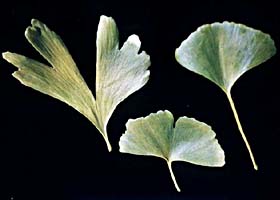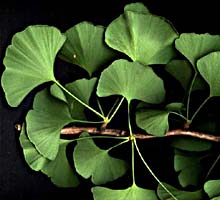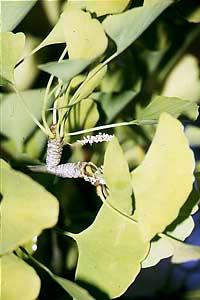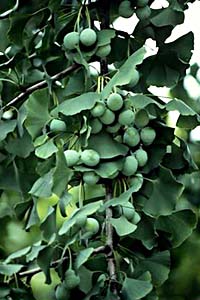







The fan shaped leaves of Ginkgo are flat and irregularly notched. They are often deeply grooved in the middle of the leaf, producing two distinct lobes, hence the name Ginkgo biloba (two lobes). The extent of the division between the two lobes is variable among the leaves, as you can see below. The leaves have a venation pattern that is open dichotomous; the veins fork in pairs from the base of the leaf, and are not cross-connected. The cuticle is hypostomatic (has recessed pores); only a few of these stomata occur on the adaxial side, while the abaxial side has many more stomatal complexes. The recessing of the pores and limited number on the leaf upper surface reduces water loss from evaporation.
 |
 |
Ginkgo leaves : On the left, a sample of the variation in leaf shape that may occur on a single tree. This variability makes it difficult to determine diversity from Ginkgo leaf fossils. On the right, a bit of a branch shows how the leaves are clustered at the tips of short shoots.
The petiole of the leaf is more or less slender and flexible. The leaves grow in clusters on the tips of short shoots up to 3 inches long, and they resemble the leaflet shape of a maidenhair fern, hence the plant's nickname, the maidenhair tree. The shoots grow off of longer horizontal or drooping branchlets.
The trunks of older trees produce peg-like structures that grow into the ground and form roots, as well as leafy branches above. The bark of the tree is grey and often deeply furrowed on older trees, while the wood inside the trunk is yellow. The leaves turn a beautiful gold in the autumn, before they fall off the tree.
Ginkgo trees, like some conifers and cycads, are dioecious, producing pollen and seeds on separate trees. Both pollen cones and seed structures grow from the spur shoots, among the leaves. Each pollen cone bears several pollen sacs. The pollen is transported by wind and produces motile sperm, not seen in the later-evolving conifers and angiosperms. The pollen cones appear in the early spring, while ovules appear in the fall and are shed with the leaves.
The ovules of a G. biloba are also produced on the spur shoots. Each consists of an egg cell embedded in the tissue of the female gametophyte surrounded by a thick seed coat. This seed coat consists of a soft fleshy outer layer, a hard stony middle layer, and a thin membranous inner layer. The ovule falls off the tree in the fall and the outer layer begins to rot away in time for the egg to be fertilized by the sperm in the spring.
 |
 |
Ginkgo cones and seeds : The left-hand image shows a pollen cone from a "male" Ginkgo tree. The small papery cone is attached to a spur shoot among the leaves. To the right, a "female" tree's branches are laden with unripened seeds. The ovules have already been pollinated, but will turn yellow, fall from the tree and begin to rot before fertilization occurs.
Ginkgo trees can also reproduce asexually. This occurs when woody structures, known as burls grow down from underneath large branches. If they contact the ground, they will root themselves and form new leaves. Actually, they are deeply embedded spur shoots with buds, but it is still unknown why this development occurs.
The ginkgo has a relatively primitive vascular system. The primary vascular system consists of a eustele and a bifacial vascular cambium. The secondary xylem is composed of thin walled tracheids and narrow vascular rays. This tracheal pitting is circular bordered and restricted to the radial walls. This is similar to conifers, suggesting that these two groups are related.
For pictures of Ginkgo anatomy, see the University of Wisconsin-Madison gopher. For more information (and pictures!) of Ginkgo biloba, go to The Virtual Garden of online resources. You may search for other topics from their frontpage.
See how (and especially why) an Iowa town created a festival around one aspect of the ginkgo's morphology.

Taylor, Thomas N. and Edith L., 1993, The Biology of Evolution of Fossil Plants, Prentice Hall, New Jersey, pp. 636-43.

